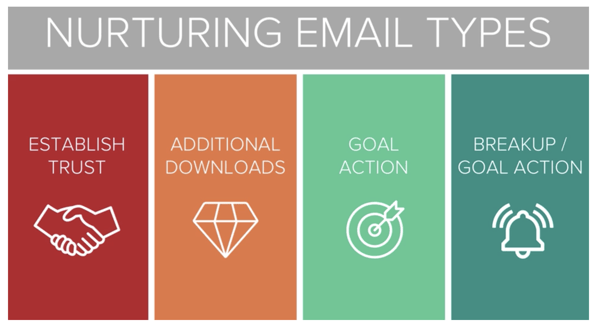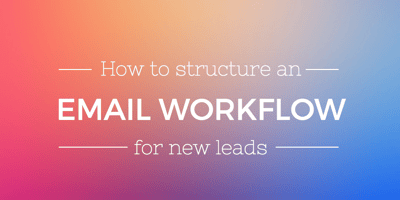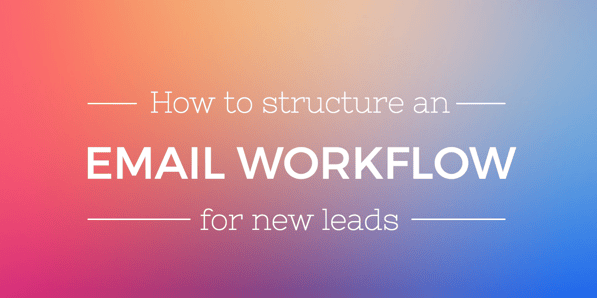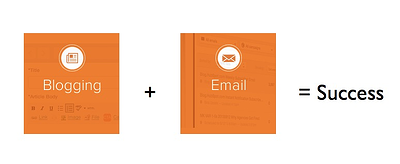So, you’ve written a great blog post that answers common questions, provides helpful information and solves some of the challenges your target audience is facing. The blog post is about a niche topic unique to your business’s services and — over the past few weeks — it’s begun to garner some organic traffic. The CTA in your post offers a simple request from your readers: “subscribe to our blog for more great insights!” New subscribers have slowly begun to trickle in… mission accomplished!
The ultimate goal of your blog is to provide useful insights that build up enough trust to convert leads into customers. But sitting and hoping your blog content alone will convert subscribers isn’t going to get the job done. You need to keep the conversation between your company and the lead running smoothly. And you need the messages you send them to be relevant, timely and effective. To put it simply, you need an effective email workflow.
What Are Email Workflows?
Workflows are a series of emails that start sending when a visitor triggers them with a specified action. That trigger can be set to virtually any action of your choosing — as long as that person has opted in to become a lead.
You can target leads based on an action they’ve taken. For instance:
- Leads who have subscribed to your blog
- Leads who have downloaded an ebook
- Leads who have viewed a specific page on your website
You could also target email workflows based on demographics. For instance:
- Leads who work for a certain size of company
- Leads with a specific job title
- Leads who live in a certain area
- Leads who are a certain age
The Value of Workflows
Workflows are vital because they take the marketer out of the equation and centralize marketing efforts around a lead’s need at that time. Rather than constantly brainstorming new messages to send out to a list of contacts, you can set up helpful emails that trigger based on a lead’s actions. This means leads only get messages they choose to receive, the marketer saves time and the emails yield higher open raters — a win/win/win situation.
“Triggered email messages yield 67.9% higher open rate and 241.3% higher click rates than standard email messages, according to Epsilon. In other words, when you use a person's behavior -- let's say that downloaded content about email workflows -- to trigger a relevant email based on that action, it will perform well.”
Email workflows allow you to gain a more complete understanding of your customer base and start segmenting those leads based on their demographics and position in the buyer’s journey.
Creating Your Email Workflow
Before setting up a workflow, it’s important that you have a thorough understanding of your established buyer personas and the typical pace of your leads’ path to purchase. Understanding your business’s two or three primary types of buyers will allow you to push the right content to leads that fit the criteria, and understanding the key touch points of your marketing and sales process will let you know when a lead is ready to be handed off to sales.
When it comes to workflows, the potential for complexity is endless. But let’s keep it simple: Going off our previous example, we want to set up a workflow for new leads who have just subscribed to our blog. What, exactly might that look like?
HubSpot separates nurturing emails into four primary types that marketers typically send to new leads. They:
- establish trust
- provide additional downloads
- have a goal action
- have a breakup action

After your lead subscribes to the blog, you’ll want to space out your messaging with logical, next-step emails. Your goal is to strengthen the relationship between the lead and your company. Though workflows will vary based on company and industry, here’s what a typical email workflow might look like:
Email 1 - triggers directly after form submission
Subject suggestion: Thanks for subscribing! We have some things for you…
In this first email, your goal is to establish trust, set expectations, and provide a valuable next step for your lead. Use a recognizable, personalized subject line (that incorporates your lead’s name). Provide value by including links (with pictures) to your most highly-engaged blog posts. Spell out the number of emails the new lead will be receiving in the coming days and why you’re sending them. The more prepared for these emails your blog subscribers are, the more likely they are to open. Make sure you thank them for subscribing to the blog!
Email 2 - triggers 3 days after submission on a weekday
Subject suggestion: Next steps for blog subscribers
For this email, your goal is to continue building trust with your lead. If you have downloadable content such as an ebook or checklist, try sending them two to three options with quick descriptions of the value of each. You can then set up further workflows that will remove leads from the current workflow and trigger a new one based on the piece of content they choose to download. Doing this allows you to gain further insight into the kind of help your leads are looking for — all while moving them along the buyer’s journey.
Email 3 - triggers 4 days after previous email on a weekday
Subject suggestion: We’ve put together something special for blog subscribers…
For the subscribers who either didn’t open the last email or didn’t download any of the content, this is a second chance. This email is similar in structure to email 2. However, if you have other downloadable content that wasn’t available, present these offers. Just like the last one, the offers you include in this email can be set up to trigger workflows of their own. Provide a little more urgency in this email. The idea is that you don’t want your blog subscribers to miss out on some of the great downloadable content you have to offer.
Email 4 - triggers 4 days after previous on a weekday
Subject suggestion: Last chance for exclusive blog subscriber offer…
If subscribers didn’t open or click on the last email, your goal is to regain their attention at all costs. Provide a single, exciting offer that is exclusive to blog subscribers. Center your copy around that one CTA and provide an engaging image that corresponds with it. This is the last marketing email you’ll send to your subscribers. From here on out, you’ll have to rely on occasional unique messages and your newsletter.
Email 5 - Triggers after 90 days of inactivity
Subject suggestion: Want to keep hearing from us?
Lack of engagement can hurt your email send and there’s no point in continuing to send messages to people who have no interest in engaging with you. The final “breakup email” is a great way to clean up your email list. It gives blog subscribers one final chance to interact with your company before you remove them from the subscriber list. In the email body, make sure you’re polite and understanding. Express to the reader that you don’t want to be just another email clogging up their inbox. Give them two links: one that opts them in to continue receiving email notifications and another that unsubscribes them from the blog. Let them make the choice and your list will be better for it.
Your Email Client
There are many different types of marketing software companies can use to create effective workflows. Naturally, we use HubSpot. We’ve found the email tool to be extremely user-friendly and efficient. In future posts, we’ll dig in to how you can use the tool to nurture leads the right way.




